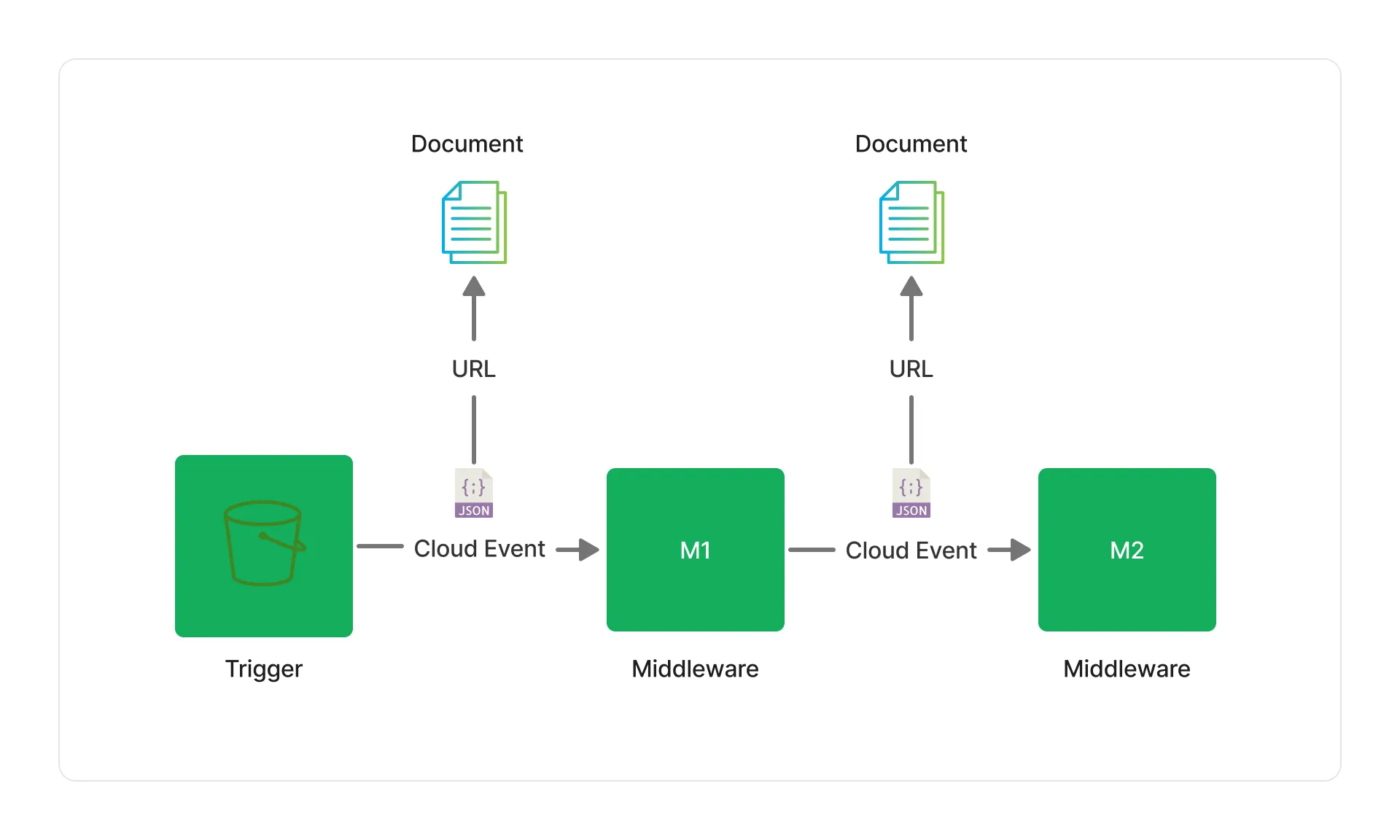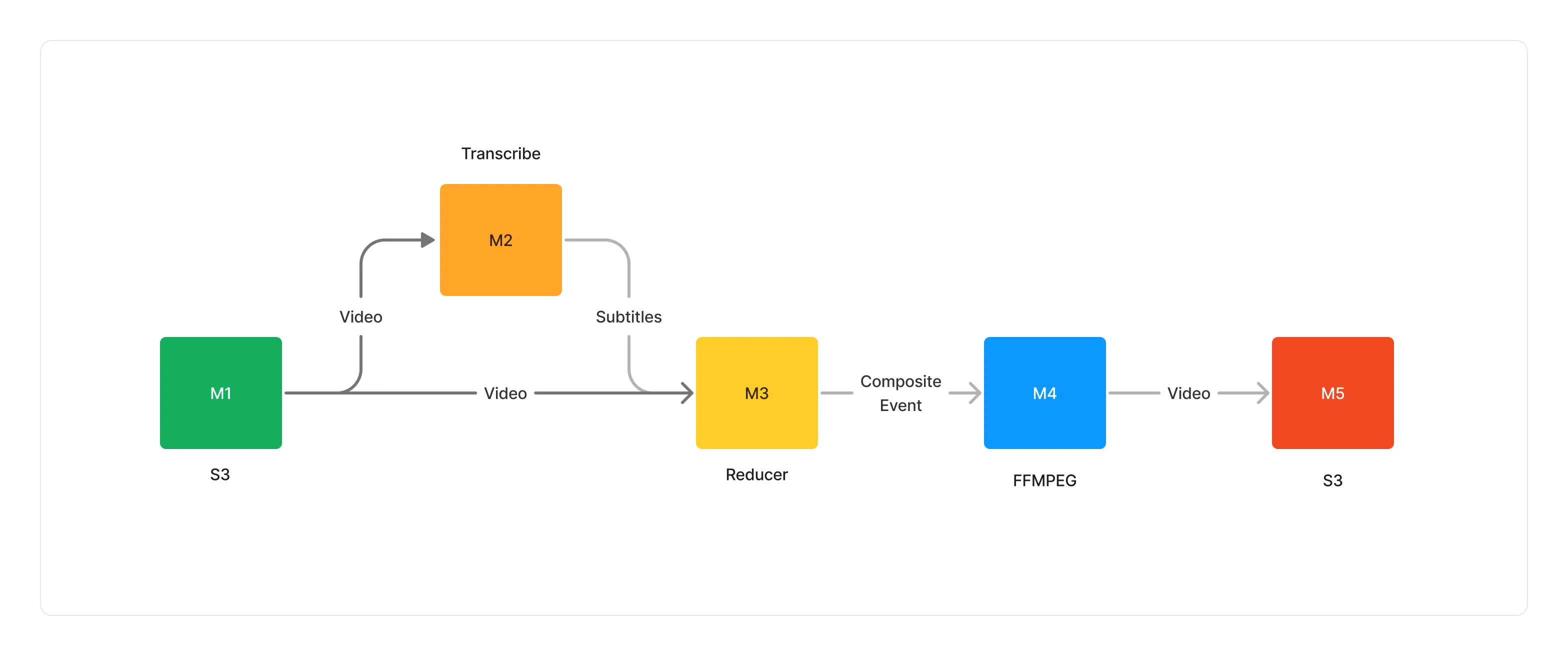Events
Project Lakechain makes a distinction between the raw data that composes a document, such as an audio file, or a text document, and the description of that document that flows through a pipeline execution. This description helps middlewares understand the type of the document, its location, and the metadata associated with it. It is the ubiquitous language that binds all middlewares together.
We call this description a Cloud Event, simply because its format is modeled after the CloudEvents specification.

📝 Description
Each Cloud Event is a JSON versioned document flowing through a pipeline execution and represents the document being processed. Below is a simple example of its structure.
{ "specversion": "1.0", "id": "1780d5de-fd6f-4530-98d7-82ebee85ea39", "type": "document-created", "time": "2023-10-22T13:19:10.657Z", "data": { "chainId": "6ebf76e4-f70c-440c-98f9-3e3e7eb34c79", "source": { "url": "s3://bucket/initial.txt", "type": "text/plain", "size": 26378, "etag": "1243cbd6cf145453c8b5519a2ada4779" }, "document": { "url": "s3://bucket/current.txt", "type": "text/plain", "size": 36872, "etag": "3a3e7eb34c79a6b2154b6f70c440c98f9" }, "metadata": {}, "callStack": [] }}Top-level Attributes
| Name | Description | Format | Mandatory |
|---|---|---|---|
| specversion | The version associated with the event format. | String | Yes |
| id | A unique identifier for the event. | UUID v4 | Yes |
| type | The type of the event. Can be document-created or document-deleted. | Enum | Yes |
| time | The date and time when the event has been created. | ISO 8601 UTC | Yes |
| data | The data envelope containing information about the document being processed. | Object | Yes |
Data Envelope
This is where most of the interesting information will be stored about the document. The data envelope carries a set of information that are consumed by every middleware in a pipeline execution:
| Name | Description | Format | Mandatory |
|---|---|---|---|
| chainId | The instance of a pipeline execution for a given document. | UUID v4 | Yes |
| source | A pointer to the initial document that triggered the pipeline. This object is read-only and remains static throughout the execution of a pipeline. | Document | Yes |
| document | A pointer to the current version of a document being processed in the pipeline. This is the pointer that is used by middlewares to chain their transformations. | Document | Yes |
| metadata | An object containing additional metadata about the document. | Object | Yes |
| callStack | An array that keeps track of the middlewares that have so far been executed in the pipeline. This field is mostly provided for debugging purposes. | Array | Yes |
Document Type
Both the source and document fields within the data envelope are pointers to respectively, the initial source document, and the currently processed document. They are both modeled against the Document type and contain the following attributes.
| Name | Description | Format | Mandatory |
|---|---|---|---|
| url | The document location. | URL | Yes |
| type | The mime-type of the document. | Mime Type | Yes |
| size | The size, in bytes, of the document. | Number | No |
| etag | A content-based hash of the document. | String | No |
ℹ️ The URL locates where the document can be found. Lakechain currently supports
httpsands3protocols.
📖 Metadata
The metadata object contains additional information about the document. Metadata are enriched by middlewares through the lifecycle of a pipeline. For example, the Image Metadata Extractor enriches the metadata object with information such as image dimensions, EXIF tags, authors, camera model, etc.
{ "specversion": "1.0", "id": "16b350b1-43de-4b47-836f-0e92cacca305", "type": "document-created", "time": "2023-10-22T13:19:10.657Z", "data": { "chainId": "6b2154b6-7c68-46fd-a5b8-aa72751c0aee", "source": { "url": "https://example.com/image.png", "type": "image/png", "size": 410280, "etag": "3e3e7eb34c79a6b2154b6f70c440c98f9" }, "document": { "url": "https://example.com/image.png", "type": "image/png", "size": 410280, "etag": "3e3e7eb34c79a6b2154b6f70c440c98f9" }, "metadata": { "title": "My Image", "authors": [ "John Doe" ], "createdAt": "2022-02-20T12:19:22.296Z", "properties": { "kind": "image", "attrs": { "dimensions": { "width": 800, "height": 600 } } } }, "callStack": [] }}Extracting metadata from documents can help in the process of transforming unstructured data into a more structured representation. When building Generative AI applications and integrating with LLMs, metadata can play an important role in your prompt engineering and help yield better results.
Top-level Attributes
The metadata object has the following top-level attributes that are common across all types of documents.
All attributes are optional.
| Name | Description | Format |
|---|---|---|
| createdAt | The date and time at which the document was created. | ISO 8601 UTC |
| updatedAt | The date and time at which the document was last updated. | ISO 8601 UTC |
| image | A URL pointing to the main image representing the document. | URL |
| authors | The list of authors of the document. | Array |
| publisher | The publisher of the document. | Publisher |
| title | The title of the document. | String |
| description | A meaningful description of the document. | String |
| keywords | An array of prominent keywords associated with the document. | Array |
| rating | A rating between 1 and 5 representing the quality of the document. | Number |
| language | The language of the document in ISO 639-1 format. | String |
| ontology | The ontology of the document in the form of a graph. | DirectedGraph |
| properties | A discriminated union of metadata specific to the type of document. | Object |
Using Pointers
The same way we reference documents in a CloudEvent, it is important to also be able to reference any other attributes that would be otherwise too large to store directly in the metadata object.
To this end, Lakechain introduces the concept of a pointer type allowing to reference large values within the metadata object.
Let’s say you are using a middleware to perform object detection on images. Instead of storing the entire list of detected objects in the metadata, the object detection middleware stores that list in an external location (which we call the cache storage), and provides a pointer to that location in the metadata. Other middlewares can lazily dereference that value when needed.
{ "specversion": "1.0", "id": "16b350b1-43de-4b47-836f-0e92cacca305", "type": "document-created", "time": "2023-10-22T13:19:10.657Z", "data": { "chainId": "6b2154b6-7c68-46fd-a5b8-aa72751c0aee", "source": { "url": "https://example.com/image.png", "type": "image/png", "size": 410280, "etag": "3e3e7eb34c79a6b2154b6f70c440c98f9" }, "document": { "url": "https://example.com/image.png", "type": "image/png", "size": 410280, "etag": "3e3e7eb34c79a6b2154b6f70c440c98f9" }, "metadata": { "properties": { "kind": "image", "attrs": { "objects": "s3://storage-bucket/detected-objects.json" // 👈 Pointer } } }, "callStack": [] }}Middlewares are responsible for serializing values into pointers, and resolve back the pointer into an object to access the underlying data at runtime.
🧩 Composite Events
Composite events in Lakechain represent a paradigm shift from processing singular, discrete events to managing a collection of related documents as a single, cohesive unit. These events are particularly useful in workflows where the relationship between documents are just as important as the documents themselves.
This grouping allows multiple documents sharing a common context to be processed together, maintaining their semantic relationship throughout the pipeline.
Example
Let’s picture a simple use-case where you want to build a multi-language video subtitling pipeline.
In that case, your pipeline would be handling a collection of multi-lingual subtitles, and a video. By aggregating multiple documents together, you create a semantically coherent envelope that can be consumed as a whole by a middleware (e.g the FFMPEG middleware) which will stitch the subtitles with the video, effectively transforming a collection of documents into a single one.

The only middleware capable of producing composite events is the Reducer middleware which can aggregate, according to different strategies, multiple events together. This allows you to model and express complex map-reduce pipelines in a simple and efficient way.
Structure
Lakechain defines a specific document mime-type for composite events. This event has the same structure as any cloud event, with the following specificities.
- It has the
application/cloudevents+jsonmime-type. - The content of the document is a JSON array of Cloud Events.
- It can contain any number of events.